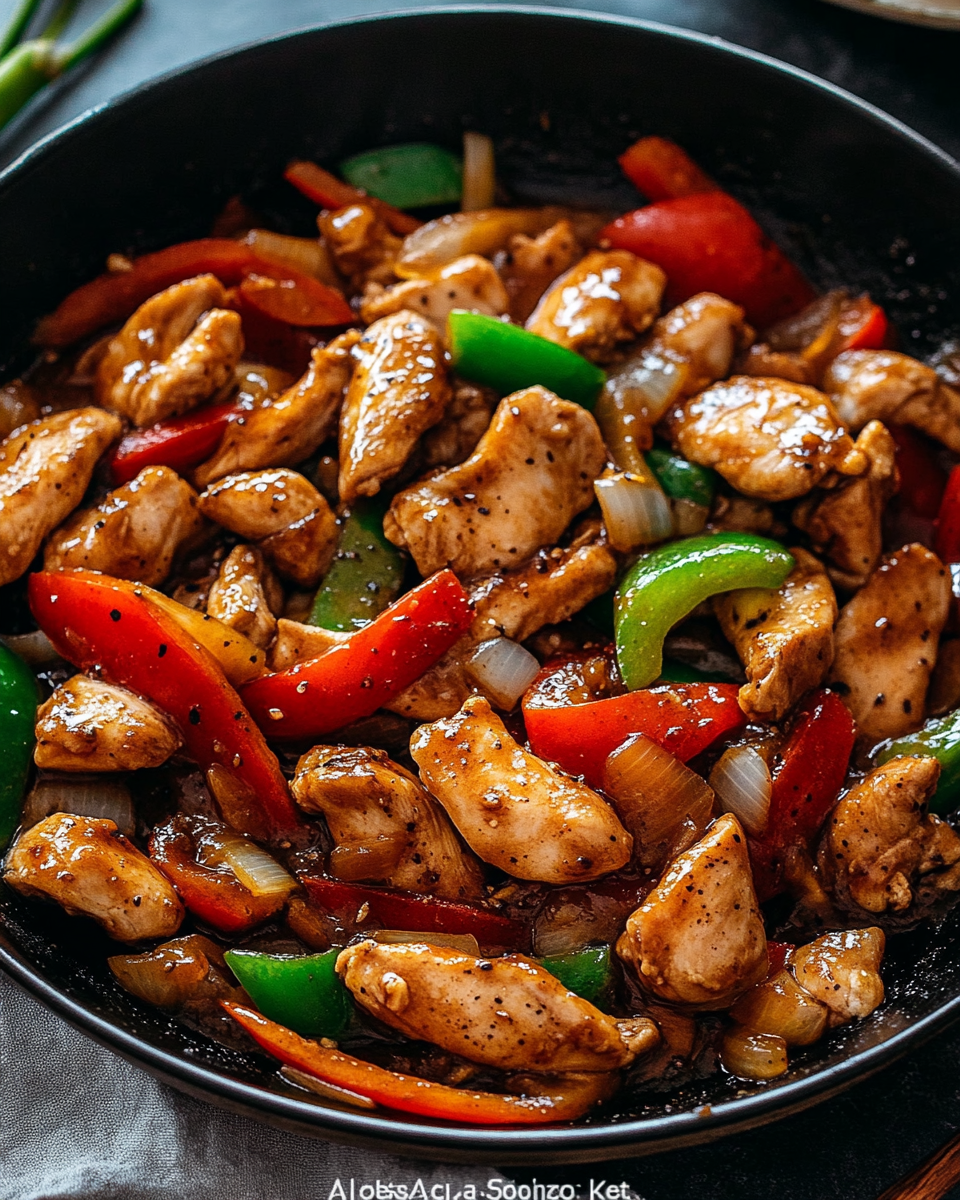The bold kick of freshly ground black pepper meets tender bites of juicy chicken in this irresistible Black Pepper Chicken Stir-Fry. Bell peppers and onions balance the spice with their natural sweetness, while the silky oyster sauce-based glaze ties everything together beautifully.
Perfect for a weeknight dinner, this dish delivers restaurant-quality flavor in less than 30 minutes. It’s also endlessly adaptable, swap in your favorite veggies, double up the sauce for extra richness, or serve over rice, noodles, or even cauliflower rice for a lighter twist. A quick and tasty meal that’ll become a regular in your kitchen rotation.
Full Recipe:
Ingredients:
-
1 lb (450 g) boneless, skinless chicken thighs, cut into bite-sized pieces
-
1 tablespoon soy sauce
-
1 tablespoon Shaoxing wine
-
1 teaspoon cornstarch
-
2 tablespoons oil (divided)
-
1/2 onion, sliced
-
1 bell pepper, sliced
-
2 cloves garlic, minced
-
1 teaspoon freshly ground black pepper
-
1 tablespoon oyster sauce
-
1 tablespoon soy sauce (extra)
-
1 teaspoon sugar
-
1/4 cup chicken broth (or water)
Directions:
-
In a bowl, mix chicken with 1 tablespoon soy sauce, Shaoxing wine, and cornstarch. Let marinate for 15 minutes.
-
Heat 1 tablespoon oil in a skillet over medium-high heat. Add chicken and sear until browned and just cooked through. Remove and set aside.
-
Add remaining oil, then sauté onion and bell pepper for 2-3 minutes until slightly tender.
-
Add garlic and stir for 30 seconds. Return chicken to the pan.
-
Add black pepper, oyster sauce, extra soy sauce, sugar, and chicken broth. Stir-fry for another 1-2 minutes until everything is well coated and sauce thickens slightly.
-
Serve hot with steamed rice.
Prep Time: 15 minutes | Cooking Time: 10 minutes | Total Time: 25 minutes
Kcal: 310 kcal | Servings: 3 servings
Black Pepper Chicken: Bold, Savory, and Ready in Minutes
Few dishes strike the perfect balance between spice, aroma, and simplicity like Black Pepper Chicken. This classic Chinese stir-fry is a staple in many Asian households and restaurants, often seen on takeout menus for its rich flavor and rapid preparation. It’s a celebration of the mighty black peppercorn—fragrant, warming, and beautifully versatile.
What makes this dish stand out is its emphasis on basic ingredients that come together with explosive flavor. Unlike recipes that require a complicated pantry, this one leans on the power of black pepper, soy sauce, oyster sauce, and garlic—all essentials in Asian cooking. When paired with tender chicken thigh pieces and crisp veggies like bell peppers and onions, the result is a mouthwatering, glossy stir-fry that hits all the right notes: spicy, savory, slightly sweet, and deeply satisfying.
In this article, we’ll dive deep into the background of this dish, its components, cooking techniques, helpful tips, and variations. Whether you’re new to stir-frying or a seasoned cook, this guide will elevate your understanding and appreciation of Black Pepper Chicken.
A Culinary Tribute to Black Pepper
Black pepper, often underestimated, is the star of this dish. Historically known as “black gold,” it was once so valuable that it was used as currency. Indigenous to India’s Malabar Coast, black pepper has made its way across the globe and into every cuisine.
In Chinese cuisine, black pepper plays a bolder, more dominant role than its more subdued use in Western dishes. Instead of merely seasoning, it becomes a central flavor component—providing heat without the burning spice of chili, while adding depth and aroma. The coarsely ground pepper not only seasons the dish but also forms a key part of its iconic glossy sauce.
Why Chicken Thighs Work Best
While chicken breast is a popular lean protein, chicken thighs reign supreme in stir-fry dishes. Their slightly higher fat content ensures juicy, tender bites even after quick high-heat cooking. Thighs hold flavor better, and their texture is more forgiving, especially in dishes where the meat is chopped and stir-fried.
That said, if you’re looking to make the dish leaner, you can still use chicken breast. Just be sure not to overcook it. Consider marinating it a few extra minutes and slicing it thinly against the grain to keep it tender.
Building the Perfect Sauce
The sauce in Black Pepper Chicken is deceptively simple but remarkably flavorful. Here’s a breakdown of its components:
-
Soy Sauce: Offers a rich, umami base. Use both light and dark soy sauce if you have them. Dark soy adds color and a deeper, caramelized flavor.
-
Oyster Sauce: Thick, slightly sweet, and packed with umami, it binds the sauce and gives it a restaurant-style gloss.
-
Shaoxing Wine: A touch of this fermented rice wine adds complexity and aroma. Dry sherry or mirin (with adjusted sugar) can be used as substitutes.
-
Sugar: Just a hint balances the heat of black pepper and the saltiness of soy sauce.
-
Chicken Broth or Water: Loosens the sauce and helps it coat the chicken and veggies evenly.
The key is to stir-fry the sauce with the chicken just long enough for it to thicken and cling—no longer. Overcooking can dull the fresh peppery aroma.
Essential Vegetables and Aromatics
This dish thrives on simplicity. Onions and bell peppers are ideal for their sweetness and crunch, but you can switch things up depending on what you have on hand. Here are a few options:
-
Snow peas: For color and crunch
-
Mushrooms: Earthy tones that complement pepper
-
Broccoli florets: Soak up sauce and add texture
-
Zucchini or carrots: For sweetness and balance
As for aromatics, garlic is essential. Ginger can also be added for a zingy warmth, though it’s not necessary for the traditional version.
Mastering the Wok Technique
The heart of any stir-fry is technique. The goal is to cook ingredients quickly over high heat while preserving texture and maximizing flavor.
Here’s how to master it:
-
Prep everything before cooking. Stir-frying moves fast, and there’s no time to chop once you start.
-
Use a large pan or wok. Overcrowding leads to steaming rather than stir-frying. If needed, cook in batches.
-
Preheat your pan. Wait until it’s hot enough for oil to shimmer. This prevents sticking and ensures even cooking.
-
Cook the meat separately. Brown the chicken first, remove it, cook the veggies, then recombine with sauce. This prevents sogginess and ensures seared flavor.
-
Don’t overcook the sauce. Once it bubbles and thickens slightly, it’s done. Too long, and it reduces too much or becomes salty.
Variations and Dietary Adaptations
One of the best things about Black Pepper Chicken is how flexible it is:
-
Low-Carb/Keto: Serve with cauliflower rice or shirataki noodles. Omit sugar or use a low-carb sweetener.
-
Gluten-Free: Use tamari instead of soy sauce and ensure oyster sauce is gluten-free.
-
Vegetarian: Use tofu or mushrooms in place of chicken. Replace oyster sauce with mushroom sauce.
-
Spicy: Add chili flakes or fresh Thai chilies if you crave extra heat.
This dish can also be turned into a rice bowl, noodle topping, or lettuce wrap filling. It reheats well and even tastes better the next day as the flavors deepen.
Serving Suggestions
Traditionally, Black Pepper Chicken is best served with freshly steamed jasmine or white rice. The rice soaks up the sauce and tempers the pepper’s bite. You can also try:
-
Fried rice as a heartier pairing
-
Rice noodles for a lo mein-style twist
-
Brown rice for a healthier base
-
Lettuce cups for a lighter option
-
On its own for a low-carb meal prep idea
Garnish with chopped scallions or sesame seeds for extra texture and visual appeal.
Storing and Meal Prep Tips
This dish is a fantastic meal prep candidate. Store in an airtight container for up to 3–4 days in the fridge. When reheating, gently warm on the stovetop or in the microwave with a splash of water to loosen the sauce.
You can even double the sauce and freeze it separately to save time on future stir-fries. Having the sauce on hand turns this into a 10-minute weeknight miracle.
Conclusion: A Simple Yet Flavorful Classic
Black Pepper Chicken proves that bold flavors don’t require a long list of ingredients or hours in the kitchen. With a quick marinade, fast stir-fry method, and pantry-staple sauce, you can serve up a restaurant-style dish that’s fresher and healthier than takeout. Its balance of heat, umami, and natural sweetness makes it universally appealing.
Whether you’re cooking for yourself, your family, or guests, this recipe is sure to impress. And once you’ve mastered it, you’ll find yourself returning to it again and again—experimenting with proteins, vegetables, and spice levels to make it your own.






